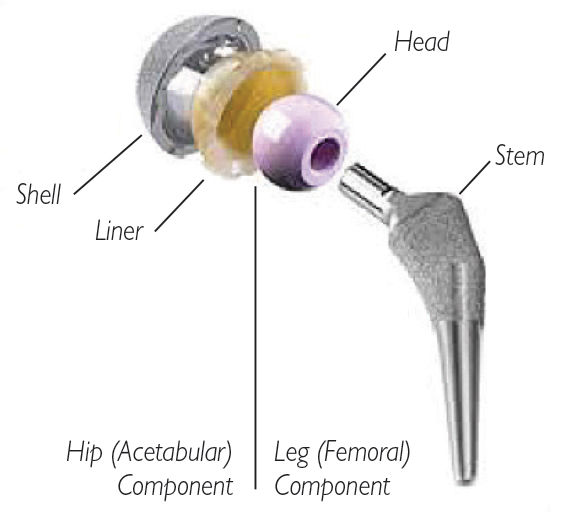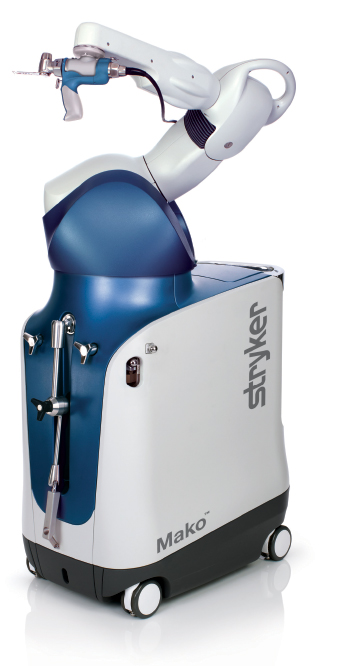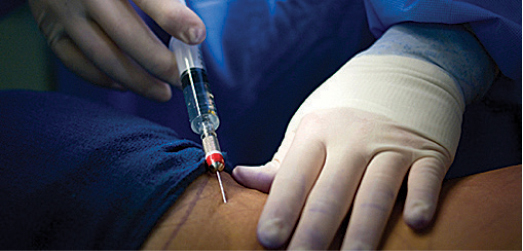Rapid Recovery After Hip and Knee Replacement Surgery
Nathaniel Stewart, MD & Kate Nelson, PA-C
Orthopedic Surgery
Chippewa Valley Orthopedics & Sports Medicine
Altoona
 The implementation of a rapid recovery program in elective orthopedic surgery has helped to improve surgical outcomes and patient satisfaction. Over the past several years, we have utilized numerous strategies and medical advancements to allow for faster recovery, including long acting local anesthetics, multimodal pain control, early mobilization and the use of intraoperative robotics. These improvements have led to a shorter length of hospital stay, reduced postoperative complications and improved accuracy of the placement of the surgical components. We will outline the techniques involved in rapid recovery protocols.
The implementation of a rapid recovery program in elective orthopedic surgery has helped to improve surgical outcomes and patient satisfaction. Over the past several years, we have utilized numerous strategies and medical advancements to allow for faster recovery, including long acting local anesthetics, multimodal pain control, early mobilization and the use of intraoperative robotics. These improvements have led to a shorter length of hospital stay, reduced postoperative complications and improved accuracy of the placement of the surgical components. We will outline the techniques involved in rapid recovery protocols.
Direct Anterior Total Hip Replacement Surgery
The direct anterior approach is an increasingly popular method to perform total hip replacement surgery. An approach is the location the surgeon uses to access the hip joint at the time of the hip replacement surgery; therefore, the anterior approach allows the surgeon to get to the hip joint from the front of the patient. The direct anterior approach allows for faster recovery due to a smaller incision and no cutting of the muscles at the time of the procedure. Additional benefits of the direct anterior approach include a reduced risk of hip dislocation and improved accuracy of the placement of the components.
Dr. Stewart switched from using the posterior approach
to the direct anterior approach when performing
hip replacement surgery in 2013. As of January 1, 2018,
Dr. Stewart has performed 555 hip replacements
using the direct anterior approach. We have noticed
marked improvements in the accuracy of component positioning during hip replacement surgery using the
direct anterior approach.
The rapid recovery program has also allowed an opportunity for our healthier patients to undergo bilateral total hip arthroplasties.
Dr. Stewart began performing bilateral total hip arthroplasties in
2015 for patients with severe osteoarthritis in both hips. Bilateral total hip arthroplasties allow patients to reduce the length of recovery in comparison to undergoing two consecutive hip replacements, which would ideally need to be spaced out at least 6–12 weeks apart. This has been an advantage for some of our patients, such as farmers and self-employed individuals who have a difficult time finding coverage for their business while recovering from two consecutive hip replacements.
 Utilization of Robotics during Hip & Knee Surgery
Utilization of Robotics during Hip & Knee Surgery
Accurately placing total hip components, total knee components and partial knee components is a difficult process. However, it is an essential factor that contributes to the durability of the implant and a patient’s satisfaction with their joint replacement. The use of robotics during hip and knee surgery has allowed for improved accuracy of the placement of components. Prior to undergoing robotic hip or knee surgery, a CT scan is obtained to use for surgical planning purposes. Your surgeon then plans your hip or knee replacement surgery on a computer, which is very similar to a computer aided design (CAD) work station used in many other industries.
During the operation, the computer needs to “register” where your bony anatomy is in space. The surgeon uses a surgical instrument called a “pointer” to complete this registration process. Once the computer has registered all of the bony landmarks, and it correlates to the CT scan that was obtained prior to surgery, the surgeon may begin the process of hip or knee replacement. Robotics allows for a new level of precision that had not previously been available to orthopedic surgeons performing hip and knee replacement surgery. In April of 2016, we began utilizing robotics in hip replacement surgery, which further improved the accuracy of component positioning, and thus, longevity of the implant. As of January 1, 2018, Dr. Stewart has performed 196 hip replacements using robotics.
Advancements in Medications
 Multimodal pain control has been a major contributing factor to allow for rapid recovery following hip and knee replacement surgery due to better management of pain postoperatively. We provide our patients several types of analgesia preoperatively, intraoperatively and postoperatively, along with compression and cold therapy to ensure adequate pain control. During surgery, a long acting local anesthetic is injected into the tissues prior to closure. Additionally, our patients are given scheduled Tylenol and a small amount of narcotics, which helps to keep postoperative pain to a minimum. Adequate pain control is essential postoperatively in order to allow our patients to ambulate more quickly following their hip or knee surgery. We encourage our patients to walk within a few hours of arriving to the floor and to continue walking every few hours following their surgery.
Multimodal pain control has been a major contributing factor to allow for rapid recovery following hip and knee replacement surgery due to better management of pain postoperatively. We provide our patients several types of analgesia preoperatively, intraoperatively and postoperatively, along with compression and cold therapy to ensure adequate pain control. During surgery, a long acting local anesthetic is injected into the tissues prior to closure. Additionally, our patients are given scheduled Tylenol and a small amount of narcotics, which helps to keep postoperative pain to a minimum. Adequate pain control is essential postoperatively in order to allow our patients to ambulate more quickly following their hip or knee surgery. We encourage our patients to walk within a few hours of arriving to the floor and to continue walking every few hours following their surgery.
Fast Track Recovery Program
We recently began the Fast Track Recovery Program at OakLeaf Surgical Hospital in which a select group of patients are discharged home the same day as their surgery. Patients can select the Fast Track Recovery Program preoperatively in consultation with their surgeon. These patients undergo extensive education and have their physical therapy prearranged to start on the first postoperative day to ensure they receive prompt and appropriate care following their surgery. All of our fast track patients go to a class where they learn about their surgery. Additionally, they go to pretherapy where they meet with a physical therapist and learn exercises they will be doing postoperatively so they are ready and prepared to recover at home. The therapist will also assist them in learning how to use crutches and/or a walker so they feel comfortable using them after surgery. The goal of rapid recovery is not to have the patient go home before they are ready, but to have them feel better quickly so they can go home and be where they are most comfortable while they are recovering from surgery.
Nathaniel Stewart, MD – Chippewa Valley Orthopedics & Sports Medicine
For information or to schedule an appointment:
715-832-1400 | 800-322-1747 | cvosm.com
Dr. Stewart sees patients in Altoona, Chippewa Falls, Ladysmith and Rice Lake.

 Kate Nelson, PA-C
Kate Nelson, PA-C

 The implementation of a rapid recovery program in elective orthopedic surgery has helped to improve surgical outcomes and patient satisfaction. Over the past several years, we have utilized numerous strategies and medical advancements to allow for faster recovery, including long acting local anesthetics, multimodal pain control, early mobilization and the use of intraoperative robotics. These improvements have led to a shorter length of hospital stay, reduced postoperative complications and improved accuracy of the placement of the surgical components. We will outline the techniques involved in rapid recovery protocols.
The implementation of a rapid recovery program in elective orthopedic surgery has helped to improve surgical outcomes and patient satisfaction. Over the past several years, we have utilized numerous strategies and medical advancements to allow for faster recovery, including long acting local anesthetics, multimodal pain control, early mobilization and the use of intraoperative robotics. These improvements have led to a shorter length of hospital stay, reduced postoperative complications and improved accuracy of the placement of the surgical components. We will outline the techniques involved in rapid recovery protocols.  Utilization of Robotics during Hip & Knee Surgery
Utilization of Robotics during Hip & Knee Surgery Multimodal pain control has been a major contributing factor to allow for rapid recovery following hip and knee replacement surgery due to better management of pain postoperatively. We provide our patients several types of analgesia preoperatively, intraoperatively and postoperatively, along with compression and cold therapy to ensure adequate pain control. During surgery, a long acting local anesthetic is injected into the tissues prior to closure. Additionally, our patients are given scheduled Tylenol and a small amount of narcotics, which helps to keep postoperative pain to a minimum. Adequate pain control is essential postoperatively in order to allow our patients to ambulate more quickly following their hip or knee surgery. We encourage our patients to walk within a few hours of arriving to the floor and to continue walking every few hours following their surgery.
Multimodal pain control has been a major contributing factor to allow for rapid recovery following hip and knee replacement surgery due to better management of pain postoperatively. We provide our patients several types of analgesia preoperatively, intraoperatively and postoperatively, along with compression and cold therapy to ensure adequate pain control. During surgery, a long acting local anesthetic is injected into the tissues prior to closure. Additionally, our patients are given scheduled Tylenol and a small amount of narcotics, which helps to keep postoperative pain to a minimum. Adequate pain control is essential postoperatively in order to allow our patients to ambulate more quickly following their hip or knee surgery. We encourage our patients to walk within a few hours of arriving to the floor and to continue walking every few hours following their surgery.